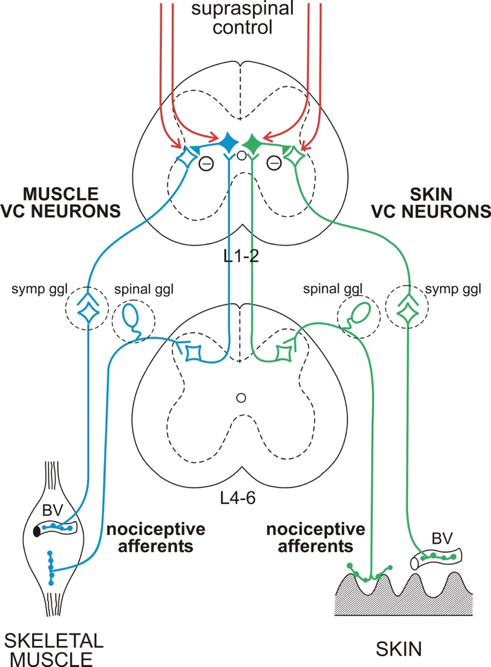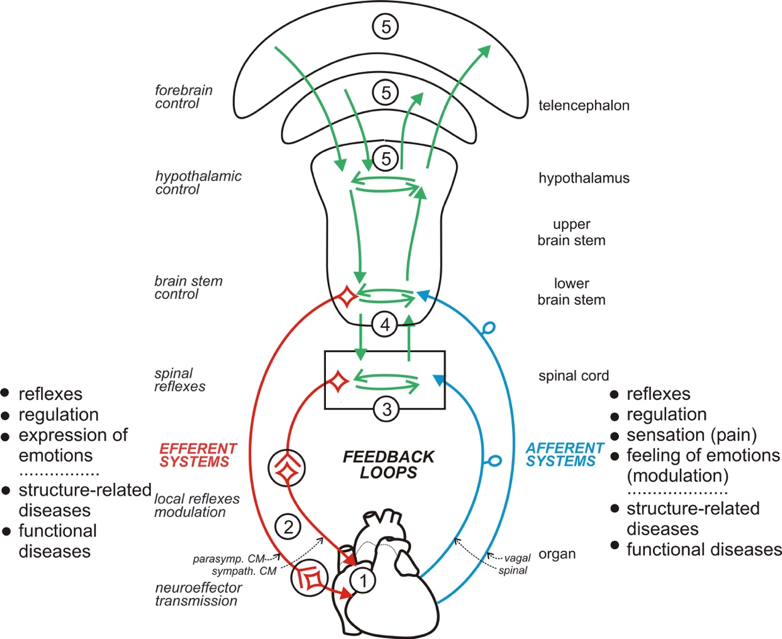
NEUROBIOLOGY OF AUTONOMIC NERVOUS SYSTEM FUNCTIONS, INTEROCEPTION AND PAIN
II Edition in BARCELONA
Course 1: 9 – 12 November 2018
Neurobiology of the autonomic nervous system
Course 2: 22 – 25 February 2019
Neurobiology of nociception and pain
Osteopathic medicine (and other forms of manual medicine) is a form of integrative medicine that is conceptually based in its therapeutic approach on the unity of body and mind. Health and disease are biologically the result of regulation or dysregulation of the body by the brain. During diseases, that are the consequence of the dysregulation of the brain-body axis, the therapeutic aim is therefore to activate and promote the evolutionary developed mechanisms underlying health and healing. Various peripheral and central neural systems are involved in the regulation of health and healing: (1) Peripheral autonomic systems innervating and regulating the body tissues. (2) Central systems in spinal cord, brain stem and hypothalamus involved in autonomic reflexes and regulations. (3) Ascending afferent interoceptive systems monitoring the mechanical, thermal, metabolic, inflammatory and injured states of the body tissues and reporting them to the brain. This includes the systems of nociception and pain. (4) Neuroendocrine systems influencing all tissues. (5) Representations of the body tissues in the forebrain that integrate interoception and functions of autonomic systems (reflexes, homeostatic regulations) resulting in cortical control of the body tissues. This includes mental processes such as sensations, feelings of emotions, perceptions as well as cognition.
How are these systems integrated? This integration occurs principally at all levels of organization of the systems, i.e. from the level of the body tissues to the telencephalic level. Thus, each system is not only organized in itself in a hierarchical way, but the integration between systems is also hierarchically organized. Disentangling the mechanisms underlying this integration will give us a better insight as to how these systems work at the cellular and integrative level in health and disease. To understand the integral neuronal processes is the entrance gate to understanding the mechanisms underlying the various manual therapeutic procedures used in treatment of functional diseases and dysfunctional states of the body tissues and to improve the therapies.
Two examples coming from the laboratory may briefly demonstrate this:
- Inhibitory nociceptive reflexes cutaneous and muscle vasoconstrictor (VC) neurons. It is generally believed that stimulation of nociceptors leads to reflex activation of VC neurons with increase of arterial blood pressure and decrease of blood flow through the tissues. This assumption is only true to a rather limited degree and therefore potentially misleading. In vivo experimentation on rats and cats have shown that cutaneous VC neurons are inhibited during stimulation of cutaneous nociceptors innervating the same skin territory as the nociceptors but not by stimulation of muscle nociceptors of the same extremity. Muscle VC neurons are inhibited during stimulation of muscle nociceptors innervating the same extremity but not during stimulation of cutaneous nociceptors (Fig. 1). These experimentally obtained results clearly show the close integration of vasoconstrictor systems and nociceptive systems at the spinal cord level (Kirillova-Woytke et al 2014).
- Neural regulation of the heart: Levels of integration and afferent feedback. Fig. 2 illustrates the peripheral and central neural systems being involved in regulation of the heart and the integration between the autonomic systems innervating the heart and the afferent feedback from the heart. This integration occurs at various levels: the organ (1 in Fig. 2), the autonomic ganglia (2), the spinal cord (3), the lower brain stem (4) as well as the hypothalamus and telencephalon (6). It shows that neural regulation of the heart by the brain involves various mechanisms. These mechanisms are only partially understood (Jänig 2016).
The two workshops organized by Prof. Wilfrid Jänig will concentrate on the following topics:
— Neurobiology of the autonomic nervous system: peripheral and central organization. This includes the autonomic regulation of functions of the gastrointestinal tract by the enteric nervous system and by the brain, regulation of immune system and inflammation involving the autonomic nervous system.
— Neurobiology of interoception, nociception and pain: peripheral and central organization.
— Peripheral and central interaction and integration of nociceptive as well as other interoceptive systems on one side and autonomic systems under physiological and pathophysiological conditions on the other. This includes the telencephalic control of autonomic and interoceptive systems and their integration.
— The complex regional pain syndrome as a model of integration: pain, sympathetic nervous system and control by the brain.
— The whole-body approach in osteopathic/manual medicine in the light of modern neurobiology of the regulation of body tissues.
The aim is to structure the teaching in an interactive way. The participants will be supplied with the essence of the lectures and with literature.

Prof. Dr. Wilfrid Jänig
Physiologisches Institut
Christian-Albrechts-Universität zu Kiel
Olshausenstr. 40
24098 Kiel
Germany
References
Craig, A.D. (Bud) How do you feel? An interoceptive moment with your neurobiological self. Princeton University Press. Princeton, Oxford (2015)
Jänig, W. The integrative action of the autonomic nervous system. Neurobiology of homeostasis. Cambridge University Press, Cambridge (2006)
Jänig, W. Autonomic nervous system and pain. In Basbaum, A.I. Bushnell, M.C. (eds.) Science of Pain. Academic Press, San Diego, pp. 193-225 (2009)
Jänig W. The autonomic nervous system and pain: neurobiological mechanisms. In Mathias, C.J., Bannister, R. (eds.) Autonomic Failure. Oxford University Press, Oxford, 5. edition, pp. 236-246 (2013)
Jänig, W. Neurocardiology: a neurobiologist´s perspective. J. Physiol. in press (2016)
Jänig, W. The autonomic nervous system. In Galizia, G., Lledo, J.-M. (eds.) Neurosciences – From Molecule to Behavior: A University Textbook. Springer-Verlag, Berlin Heidelberg, pp. 179 – 211 (2013)
Jänig, W., Böhni, U., von Heymann, W. Interozeption, Schmerz und vegetatives Nervensystem. In: Böhni, U., Lauper, M., Locher, H. (eds.) Manuellen Medizin I: Fehlfunktion und Schmerz am Bewegungsorgan verstehen und behandeln. Georg Thieme Verlag, Stuttgart New York, pp. 69 – 100 (2015) [will be translated into English]
Jänig, W., Levine, J.D. Autonomic, endocrine, and immune interactions in acute and chronic pain. In McMahon, S.B., Koltzenburg, M., Tracey I, Turk DC (eds.) Wall and Melzack´s Textbook of Pain, 6. edition, Elsevier Churchill Livingstone, Amsterdam Edinburgh, pp. 205-218 (2013)
Jänig, W., McLachlan, E.M. Neurobiology of the autonomic nervous system. In Mathias, C.J., Bannister, R. (eds.) Autonomic Failure. Oxford University Press, Oxford, 5. Auflage, pp. 22 – 34 (2013)
Jänig, W., Schaumann, R., Vogt, W. (eds.) CRPS. Complex Regional Pain Syndrome. SUVACARE, Luzern (2013) [from the internet in German or French under http://www.SUVA.ch/waswo/2771.d]
King, H.H., Jänig, W., Patterson, M.M. (eds.) The Science and Clinical Application of Manual Therapy. Churchill Livingstone Elsevier, Edinburgh (2011) [this book critically discusses the translation from the basics to application of manual therapy]
Kirillova-Woytke, I., Baron, R., Jänig, W. Reflex inhibition of cutaneous and muscle vasoconstrictor neurons during stimulation of cutaneous and muscle nociceptors. J. Neurophysiol. 111, 1833-1845 (2014)
Mathias, C.J., Bannister, R. (eds.) Autonomic Failure. Oxford University Press, Oxford, 5. edition, 2013 [at present the best and most extensive textbook on the basics, pathophysiology and clinics of the autonomic nervous system]
Robertson, R., Biaggioni, I., Burnstock, G., Low, P.A., Paton, J.F.R. (eds.) Primer of the Autonomic Nervous System. 3rd edition, Elsevier Academic Press, Oxford, (2012) [a book to look up quickly a subject]

Figure 1. Organization of inhibitory nociceptive reflexes in cutaneous vasoconstrictor (VC) neurons (right) and muscle VC neurons: a hypothesis. Stimulation of muscle nociceptors inhibits muscle VC neurons but not cutaneous VC neurons. Stimulation of cutaneous nociceptors inhibits cutaneous VC neurons but not muscle VC neurons. The inhibitory reflexes are organized at the level of the spinal cord, largely lateralized and under supraspinal control. BV, blood vessel; symp ggl, sympathetic ganglion; spinal ggl, spinal ganglion (Kirillova-Woytke et al 2014).

Figure 2. Schematic figure showing the neural regulation of the heart: levels of integration and afferent feedback (spinal, vagal). 1, neuroeffector transmission. 2, transmission and integration in autonomic ganglia. 3, integration in spinal cord. 4, integration in lower brain stem. 5, integration in hypothalamus and telencephalon. Pathophysiological changes of the heart result in structure-related cardiac diseases including functional and structural neural remodelling. Changes of neural regulation of the heart by the brain may produce functional cardiac diseases mediated by the autonomic innervation. CM cardiomotor (Jänig 2016)



